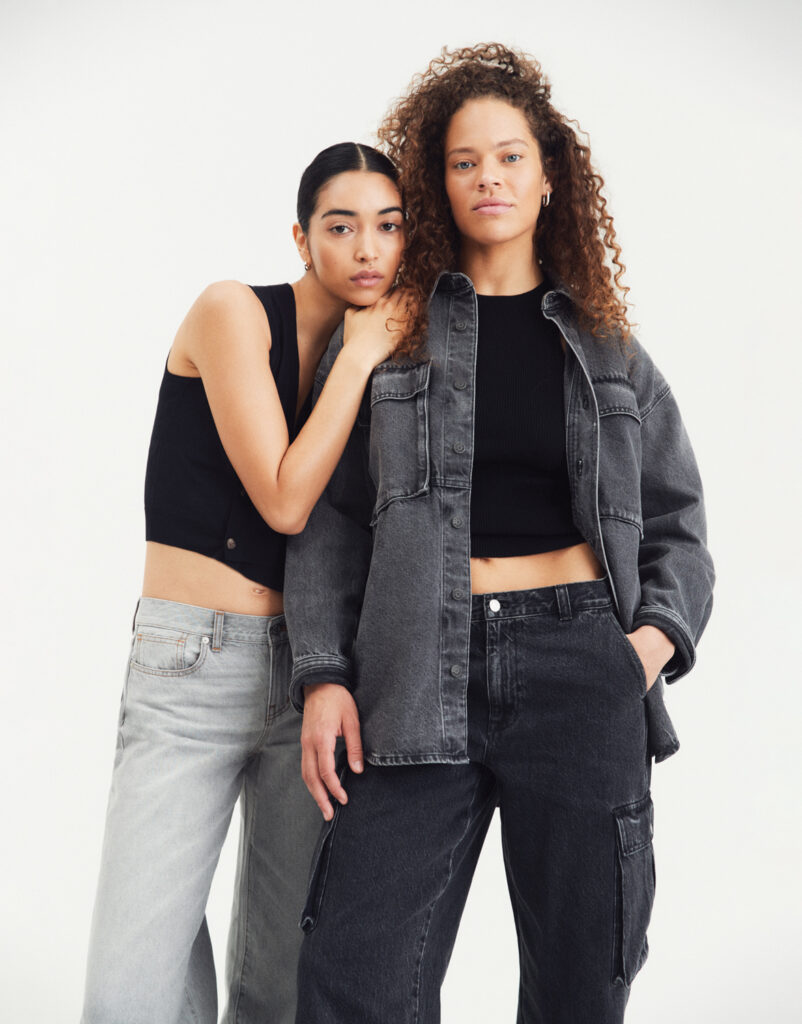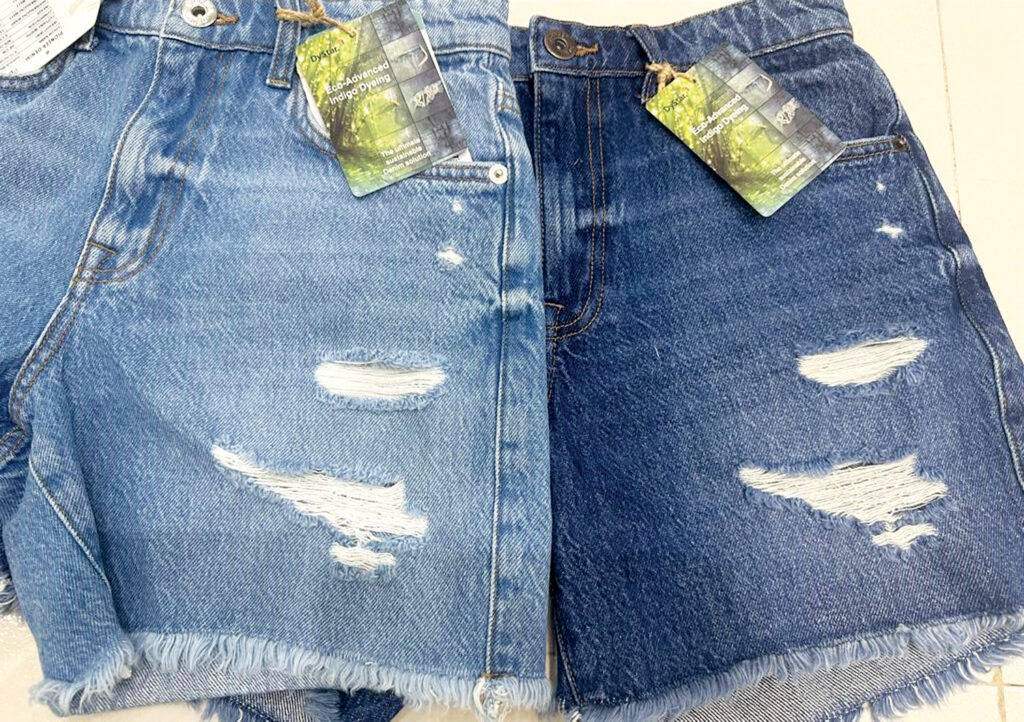
Denim has long been an icon in fashion design. In the mid-1800s, Levi Strauss began using this textile to produce clothing for those doing hard physical labor like gold mining. Today, denim clothing styles are as varied as the fabric itself. Unfortunately, toxic chemicals have historically been used throughout the entire denim production process—but now, more companies are embracing sustainable manufacturing practices.
Denim is a unique product in the fashion world where there is a two-step process to achieve the end product. According to Kutay Saritosun, director of brand services and partnerships at bluesign®, a sustainability solutions provider for the textile industry, step one involves the denim fabric production and step two is the laundry process.
Typically, once the denim fabric is produced, it is cut and sewn into five-pocket jeans (without the trims) and sent to the laundry to produce the beautiful vintage “worn-in” effects that consumers love.
“Consequently, there is a high level of water consumption, energy consumption, carbon emissions and chemical use at each of these steps,” Saritosun says. “More efficient production technologies are available to reduce impact; however, there are a lot of smaller denim laundries in manufacturing countries that do not have the right environmental management systems in place regarding wastewater management and other measures.”
Founded in 2000 in Switzerland, bluesign connects chemical manufacturers, textile manufacturers and brands that share a common desire to reduce the industry’s overall impact on people and the environment. The organization works with brands of all sizes and from different segments, such as outdoor and fashion.
“What we require from a brand when they are interested in working with bluesign is the commitment to cleaner production, cleaner chemistry and efficient use of resources in their supply chain,” Saritosun says.
Once a brand identifies the suppliers it wants bluesign to work with, bluesign schedules an on-site facility assessment. This evaluation assesses how the supplier operates regarding environmental management (air emissions, water emissions, waste and wastewater management just to name a few), worker health and safety, and resource efficiency (water, energy and chemical consumption, including CO2 emissions).
“This leads to a gap analysis as we compare the status quo at the facility against the bluesign criteria,” Saritosun says. “For each of the gaps that we have identified, we propose an action plan to close those gaps so that the supplier’s production practices comply with our requirements. When the manufacturer has implemented the system and is producing according to our criteria and they are using bluesign-approved chemistry, then they can get their materials certified as bluesign approved.”
In October 2022, fashion and denim lifestyle brand Madewell partnered with bluesign as part of Madewell’s dedication to reducing its environmental impact by implementing sustainable practices in denim production.
Specifically, Madewell’s first denim style launched under the bluesign partnership was crafted using bluesign Approved ISKO™ fabrics, a certification that signifies adherence to bluesign’s strict worker safety and environmental requirements as well as the elimination of hazardous chemicals from the beginning of the fabric’s production.
In a press release announcing the partnership, bluesign CEO Daniel Rüfenacht said, “Our bluesign Denim initiative aims to revolutionize the way denim is produced, ensuring that clean chemistry and clean production processes are at the heart of the system partner mills and laundries. With Madewell as our first U.S. denim brand system partner, we are taking a major stride towards leading the industry with a transformational approach to denim production. We are expecting more brands to follow Madewell’s footsteps in joining the bluesign Denim initiative.”
Further advancements
Regarding denim fabric manufacturing and laundry processes, there are new production technologies focused on using less water and less chemistry. As Saritosun points out, innovation also exists with the chemical manufacturers producing denim chemicals that achieve the desired effects using fewer resources.
“Circularity initiatives are gaining traction in the denim industry, with mills using more and more recycled cotton, regenerated cellulosics and other non-virgin materials such as ISKO’s Ctrl+Z technology,” Saritosun says. “Waste generation is a prominent issue in the apparel world, and denim is a big contributor to that. The development and scaling up of the recycling technologies—both mechanical and chemical—enables the industry to bring the denim material and garment waste back into the economy. We are seeing more and more denim mills working with recycling facilities or establishing their own recycling units to process textile waste.”
Singapore-based DyStar is also making inroads in the denim sustainable manufacturing space. DyStar recently launched Eco-Advanced Indigo Dyeing, a technique that has proven to substantially reduce the effluent load in denim production, without compromising the quality of the end product.
In addition, according to Naceur Azraq, global technical manager of DyStar Denim, the company’s DyStar Cadira® Laundry is an eco-friendly product that aims to eliminate toxic chemicals and harmful auxiliaries from the laundry process and replace them with eco-friendly products that help save valuable resources.
Specifically, Eco-Advanced Indigo Dyeing aims to reduce water usage by up to 90% and energy consumption by up to 30% during the production process. The new dyeing technique can be used in the traditional indigo dyeing process, for sulphur dyes and colored denim.

Sustainability challenges
Worldwide, consumers, manufacturers, and brands and retailers are increasingly recognizing the importance of sustainability and its associated environmental consequences in fashion design. As Azraq at DyStar explains, this heightened awareness has influenced the company’s perspectives and spurred it into action, driving efforts to enhance processes for optimal sustainability performance.
Of course, with these efforts comes a myriad of challenges that the denim industry as a whole faces as it works to become more sustainable.
“In our opinion, apart from the adoption of sustainable products and solutions, one of the most significant forthcoming challenges lies in the effective recycling of postconsumer waste to give denim new life, thereby effectively reducing the global footprint,” says Azraq. “The transition to sustainability is being pushed by NGOs [nongovernmental organizations], brands and retailers, and various stakeholders in the textile supply chain.”
According to Saritosun, other common key challenges include:
- Supply chain complexity: Denim production involves a complex supply chain with various stages, from cotton cultivation to dyeing and finishing. Ensuring sustainability throughout this supply chain can be challenging.
- Chemical management: Reducing the use of harmful chemicals in denim production is a significant goal for sustainability. Companies may need to invest in alternative, eco-friendly dyeing and finishing processes.
- Water usage: Denim production is known to consume a significant amount of water. Sustainable denim companies must implement water-saving technologies and practices.
- Labor practices: Ensuring fair labor practices and safe working conditions throughout the supply chain is crucial for sustainability.
- Traceability: Achieving transparency and traceability in the supply chain, from raw materials to the finished product, can be complex but is essential for sustainability efforts.
- Compliance with regulations: Companies must navigate a complex web of environmental and labor regulations, which can vary by country or region.
- Consumer expectations: Meeting consumer demand for sustainable products while maintaining affordability and quality is an ongoing challenge.
Mexico-based Kaltex has been working on denim recycling for 15 years, with the goal of making the process circular. According to Eric Goldstein, executive vice president of apparel at Kaltex America, obtaining the goods is the biggest challenge right now, as Kaltex is using only postindustrial and pre-consumer waste.
“We are discussing postconsumer with many different brands at this point. There are always challenges when you are a leader in the field,” Goldstein says. “When we started mechanical recycling there was not much knowledge in the field, but now we are experts in mechanical recycling of cotton.”
Kaltex has taken steps to improve sustainability in its production processes. According to Goldstein, cotton recycling is only the beginning of the company’s sustainability statement.
“At Kaltex sustainability is not a trend—it’s a guiding principle and has been for 95 years,” he explains. “We have our own cogeneration plant for 75% of our energy usage. Our water treatment plant was built in 1995 and is one of the most efficient in the industry. We meet all ZDHC [Zero Discharge of Hazardous Chemicals] requirements and are LEED certified as well as many other certifications on sustainability. We are also the first mill in the hemisphere to be approved for RCS [recycled claim standard] cotton.”
Goldstein sees the denim industry moving toward sustainability, but it is in the very beginning stages.
“There are many brands researching it now, but it’s going to take more time. People are still learning,” Goldstein says. “We are constantly relooking at all of our processes from fiber to finished garments, and we are currently working with a few companies on and looking into some new dye techniques that are very sustainable.”
Full steam ahead
Azraq at DyStar expects there will be more room for the expression of creativity and introduction of fresh ideas to enhance sustainability within the denim industry.
And although there is much greater consumer awareness regarding sustainable consumption, Saritosun says the collective consumer action needed to move the needle toward a cleaner industry with less impact is not sufficient.
“Therefore, the upcoming legislation in the EU and possibly in the U.S. regarding the N.Y. State Fashion Act will make corporate due diligence mandatory for brands to map and disclose their supply chains, understand environmental and social impact, identify actions to reduce the impact, and report on this on a regular basis,” Saritosun says. “There are a lot of chapters under the EU Green Deal sustainable and circular textiles directive that require a certain amount of recycled content, no hazardous substances in the design of chemicals and materials, third-party verification of sustainability claims to protect consumers from greenwashing, waste management at the end of life and more. With the [Textile Exchange’s Climate+] ambitious goal of reducing carbon emissions by 45% by 2030, the legislation will help get us closer to achieving this goal.”
Maura Keller is a freelance writer based in Plymouth, Minn.
 TEXTILES.ORG
TEXTILES.ORG


